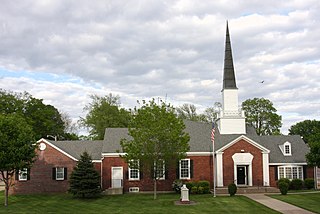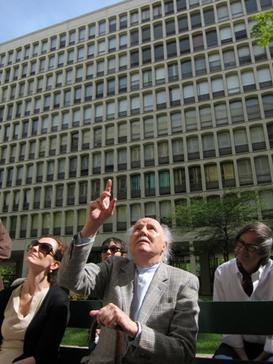
The First Church of Christ, Scientist is the administrative headquarters and mother church of the Church of Christ, Scientist, also known as the Christian Science church. Christian Science was founded in the 19th century in Lynn, Massachusetts, by Mary Baker Eddy with the publication of her book Science and Health (1875).

Solon Spencer Beman was an American architect based in Chicago, Illinois and best known as the architect of the planned Pullman community and adjacent Pullman Company factory complex, as well as Chicago's renowned Fine Arts Building. Several of his other largest commissions, including the Pullman Office Building, Pabst Building, and Grand Central Station in Chicago, have since been demolished. Beman designed numerous Christian Science churches and influenced the design of countless more.

First Church of Christ, Scientist, also known as First Christian Science Church Edifice, is a church building located in Oconto, Wisconsin. Built in 1886 of stone, weatherboard and brick in the Gothic Revival style, it was the first purpose-built Christian Science church edifice in the world. It was added to the National Register of Historic Places in 1974.

The First Church of Christ, Scientist building in Minneapolis, Minnesota, was the first of its kind in the state.

Red Rock Center for the Arts is a historic structure located at 222 East Blue Earth Avenue, in Fairmont, Minnesota, United States. It was added to the National Register of Historic Places on May 18, 1988 as the First Church of Christ, Scientist. It is now owned by Martin County, which leases it to the Martin County Preservation Association.

The former First Church of Christ, Scientist, built in 1939, is an historic Classical revival style Christian Science church edifice located at 501 Riverside Drive, overlooking the Truckee River in Reno, Nevada. Anna Frandsen Loomis, a wealthy local Christian Scientist, underwrote the $120,000 cost of the building, including land acquisition and architect's fees. She was responsible for hiring noted Los Angeles architect Paul Revere Williams, the first African-American member of the AIA. In 1998 the congregation sold the building and used the funds from the sale to construct a new church at 795 West Peckham Lane. Church member and local theater patron Moya Lear donated $1.1 million to the Reno-Sparks Theater Community Coalition, which used the funding to purchase the First Church of Christ, Scientist and renamed it the Lear Theater.

The former First Church of Christ, Scientist, built in 1940, is an historic Christian Science church building located at 391 Walnut Street on the corner of Otis Street in the village of Newtonville, in Newton, Massachusetts. It was designed in the redbrick Colonial Revival style by Densmore, LeClear and Robbins, architects. Due to cost constraints, its steeple was added later. In September, 2004, the church sold its building for $1,050,000 to be converted into apartments. The church in 2007 held services in rented rooms at 300 Walnut Street in the Masonic Building., but is now meeting at 1141 Walnut Street, in Newton Highlands. The building has since been divided into 11 condominium units. It is now called the Oxford House, and was the city's first inclusionary zoning project.
Charles Draper Faulkner was a Chicago-based American architect renowned for the churches and other buildings that he designed in the United States and Japan. He designed over 33 Christian Science church buildings and wrote a book called Christian Science Church Edifices.

The former First Church of Christ, Scientist, built in 1897, is a historic Neo-Classical-style church located at 4017 S. Drexel Boulevard in Chicago, Illinois. It was designed by noted Chicago-based architect Solon Spencer Beman, who was renowned for the churches and other buildings that he designed in the United States. In 1923 an Aeolian-Skinner organ was installed in the church. On May 7, 1950, Grant Memorial AME Church bought the building and is its present owner. First Church of Christ, Scientist, Chicago, is no longer in existence.

Seventeenth Church of Christ, Scientist, built in 1968, is a modern style Christian Science church building located in The Loop at 55 East Wacker Drive, in Chicago, Illinois in the United States. It was designed by noted Chicago-based architect Harry Weese, whose most famous work is the Washington Metro but who is remembered best as the architect who "shaped Chicago’s skyline and the way the city thought about everything from the lakefront to its treasure-trove of historical buildings."
The former First Church of Christ, Scientist, built in 1922, is an historic Classical Revival style Christian Science church located at 15422 Detroit Avenue, on the northeast corner of Detroit and Arthur avenues, across from the Public Library in Lakewood, Ohio. Its massive entrance portico is supported by six Doric columns. It was designed by noted Chicago-based architect Charles Draper Faulkner, who was renowned for the churches and other buildings that he designed in the United States and Japan. He designed over 33 Christian Science church buildings and wrote a book called Christian Science Church Edifices which features this church as well as many others.

First Church of Christ, Scientist is the main congregation for Atlanta, Georgia’s Christian Science community. Its historic Greek revival church edifice is located on the corner of Fifteenth Street, N.E., and Peachtree Street in the city's Midtown section and is a contributing property in the Ansley Park Historic District.

The former First Church of Christ, Scientist, built in 1916 in the Classical Revival style, is a historic Christian Science church edifice located at 132 E. 4th Street in Neillsville, Wisconsin. It was designed in the form of a Greek cross by Chicago architect L. J. Corbey for Christian Science Society, Neillsville, which had been organized in January, 1912 and which later became First Church of Christ, Scientist. Its front portico is supported by four large Tuscan columns. While small in size, the building projects a large presence. Its auditorium windows are of green opalescent art glass. On March 31, 2003, it was added to the National Register of Historic Places.

The former Seventh Church of Christ, Scientist building, located in the Queen Anne Hill neighborhood of Seattle, Washington at the corner of 8th Avenue W and W Halladay Street, is an historic Christian Science church edifice. Built in 1926, it was designed by noted Seattle architect Harlan Thomas in the Neo-Byzantine, Mission Revival and Spanish Colonial styles. It consists of two parts joined together to form an ell: the 2-story main section containing the church auditorium and a one-story wing containing the Sunday School. The main section is square but each corner has been "flattened to form an irregular octagon.

Fifth Church of Christ, Scientist is a historic Classical Revival-style Christian Science church building located at 9 East 43rd Street near Madison Avenue and Grand Central Terminal in Manhattan, New York City. Built in 1921 on the previous site of St. Bartholomew's Episcopal Church, Fifth Church of Christ, Scientist, occupies part of the first two stories of a 21-story office building that was originally named the Canadian Pacific Building. The church auditorium seats 1800 people.

The former First Church of Christ, Scientist, built in 1907, is an historic Christian Science church edifice located at 1443–1451 North Prospect Avenue in Milwaukee, Wisconsin. It was designed in the Classical Revival style by noted Chicago architect Solon Spencer Beman, who designed at least a dozen other Christian Science churches across the country. On March 8, 1989, it was added to the National Register of Historic Places. Today it is occupied by 1451 Renaissance Place and is the venue for weddings and other social events as well as corporate events.

The former Fourth Church of Christ, Scientist, built between 1929 and 1930, is an historic Christian Science church building located at 3069 North Downer Avenue / 2519 E. Kenwood Boulevard) in Milwaukee, Wisconsin. Designed in the Georgian Revival style of architecture by the noted Chicago-based architect Charles Draper Faulkner, the building features a redbrick exterior with Bedford limestone trim. The first services in the completed building were held on June 29, 1930. Sometime after 1996 Fourth Church relocated to 2011 East Capitol Drive in Shorewood, Wisconsin. Today the building is the Chinese Christian Church of Milwaukee

The former First Church of Christ, Scientist at 205 Albion Avenue in Fairmont, Minnesota, United States, is a historic Christian Science church building. It was designed in the Colonial Revival style by Chicago architect Charles Draper Faulkner, who was renowned for the churches and other buildings that he designed in the United States and Japan. He designed over 33 Christian Science church buildings and wrote a book called Christian Science Church Edifices, which features this church as well as many others. Built in 1937 to replace the church's previous building at 222 East Blue Earth Avenue, its steepled redbrick front elevation looks west to Wards Park and beyond that to Sisseton Lake. The church is no longer in existence and the building is now the Lakeview Funeral Home.

Araldo Cossutta was an architect who worked primarily in the United States. He worked at the firm I. M. Pei & Partners from 1956 to 1973. I. M. Pei has been among the most honored architects in the world. Cossutta was Pei's associate and ultimately his partner in the first phase of Pei's career. He was responsible for some of the firm's best-known designs from that era, including three that have received "landmark" designations in recent years. In 1973 he and Vincent Ponte left Pei's firm to form Cossutta & Ponte, which ultimately became Cossutta and Associates. The new firm designed the Credit Lyonnais Tower in Lyon, France (1977) and the Tower at Cityplace (1988) in Dallas, Texas, among other commissions.

First Church of Christ, Scientist, Brisbane is a heritage-listed site at 273 North Quay, Brisbane City, City of Brisbane, Queensland, Australia. It was designed by Lucas and Cummings, Architects. It was added to the Queensland Heritage Register on 11 March 2016.



















